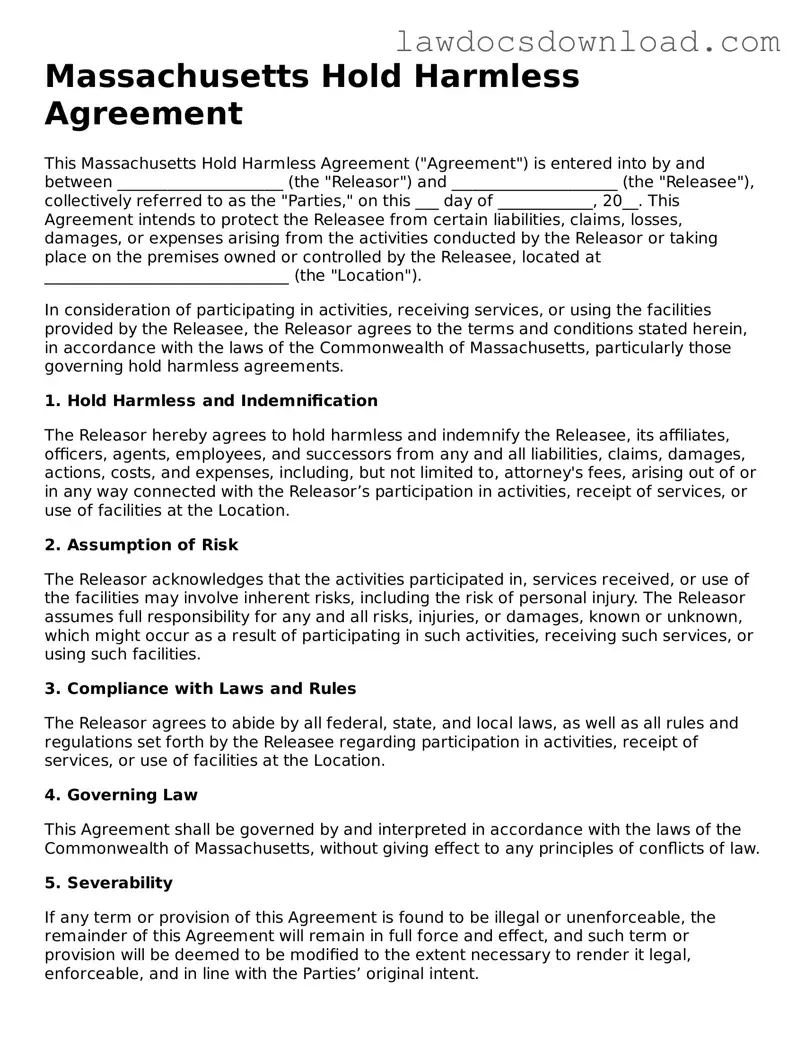Massachusetts Hold Harmless Agreement
This Massachusetts Hold Harmless Agreement ("Agreement") is entered into by and between _____________________ (the "Releasor") and _____________________ (the "Releasee"), collectively referred to as the "Parties," on this ___ day of ____________, 20__. This Agreement intends to protect the Releasee from certain liabilities, claims, losses, damages, or expenses arising from the activities conducted by the Releasor or taking place on the premises owned or controlled by the Releasee, located at _______________________________ (the "Location").
In consideration of participating in activities, receiving services, or using the facilities provided by the Releasee, the Releasor agrees to the terms and conditions stated herein, in accordance with the laws of the Commonwealth of Massachusetts, particularly those governing hold harmless agreements.
1. Hold Harmless and Indemnification
The Releasor hereby agrees to hold harmless and indemnify the Releasee, its affiliates, officers, agents, employees, and successors from any and all liabilities, claims, damages, actions, costs, and expenses, including, but not limited to, attorney's fees, arising out of or in any way connected with the Releasor’s participation in activities, receipt of services, or use of facilities at the Location.
2. Assumption of Risk
The Releasor acknowledges that the activities participated in, services received, or use of the facilities may involve inherent risks, including the risk of personal injury. The Releasor assumes full responsibility for any and all risks, injuries, or damages, known or unknown, which might occur as a result of participating in such activities, receiving such services, or using such facilities.
3. Compliance with Laws and Rules
The Releasor agrees to abide by all federal, state, and local laws, as well as all rules and regulations set forth by the Releasee regarding participation in activities, receipt of services, or use of facilities at the Location.
4. Governing Law
This Agreement shall be governed by and interpreted in accordance with the laws of the Commonwealth of Massachusetts, without giving effect to any principles of conflicts of law.
5. Severability
If any term or provision of this Agreement is found to be illegal or unenforceable, the remainder of this Agreement will remain in full force and effect, and such term or provision will be deemed to be modified to the extent necessary to render it legal, enforceable, and in line with the Parties’ original intent.
6. Entire Agreement
This Agreement constitutes the entire understanding between the Parties concerning the subject matter herein and supersedes all previous agreements, whether written or oral. Any amendments to this Agreement must be in writing and signed by both Parties.
Releasor's Signature: __________________________________ Date: ___/___/___
Releasee's Signature: __________________________________ Date: ___/___/___
Print Name of Releasor: _______________________________
Print Name of Releasee: _______________________________
Address of Releasor: __________________________________
Address of Releasee: __________________________________
Witness's Signature: ___________________________________ Date: ___/___/___
Print Name of Witness: ________________________________
